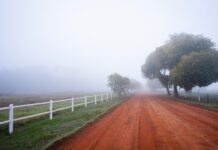You’re look out your window on a dry summer day and catch a glimpse of smoke. Only a few minutes later, a full-fledged fire is streaking across your neighbor’s lawn and threatening your home, your life and your belongings.
Oklahomans try to avoid these harrowing experiences by putting burn bans in place before tragedy strikes.
“A burn ban is what the name implies: it is when landowners in designated parts of the state are disallowed from burning because of elevated risk of wildfire,” says Keith Merckx, information representative for Oklahoma Forestry Services (OFS). He mentions that our state has two different types of burn bans and enforces them as needed.
The first, and more common, type of ban is issued by a county, and is active for seven or 14 days by the elected county commission. Commissioners can void the bans early, but generally allow them to remain in effect until they expire.
The second type of ban is issued by the governor at the recommendation of the OFS using Fire Weather and Fuel Criteria, as well as additional data related to wildland fuels conditions and predicted fire behavior. Governor-issued burn bans are more rare than county-issued bans.
“In addition to the criteria listed on the (OFS) web page, commissioners also look at: fire risk that can be the result of drought conditions existing within the county as determined by the National Oceanic and Atmospheric Administration; lack of precipitation in the National Weather Service forecast; fire occurrence significantly greater than normal for the season; initial attach on a large number of wildfires that has been unsuccessful due to extreme fire behavior; or more than 20% of the wildfires in a county having been caused by escaped debris burns or controlled burns,” says Merckx.
Enforcement agencies have discretion and latitude as to how strictly the burn bans are enforced.
“The state of Oklahoma places a high value on landowner rights, and as such, county commissioners are very deliberate in issuing bans,” says Merckx. “The hope is that common sense will rule the day and landowners will wait until the risk of wildfire has abated before burning. Occasionally, the risk to life and property becomes too great and burn bans are then issued.”
The Penalties
When tasked to do so, local and state law enforcement officials enforce the bans. Burn bans in Oklahoma are most common in the dry spring and summer months. Information from the state’s website informs citizens the penalty for violation of county-issued burn bans is being charged with a misdemeanor and subject to a fine of not more than $500, imprisonment for up to one year, or both. Violating a governor-issued ban has similar penalties, but the fine leaps up to a maximum of $1,000.
“In the spring, there is dormant vegetation that is dry from winter and ready to burn,” says Merckx. “This lack of moisture on brown vegetation can be a big hazard, but it usually gets better when plants and grasses begin to green up. In the summer, dry conditions can again cause an elevated risk of wildfire. This is traditionally the period when we see most bans issued for the longest periods of time.”
OFS maintains an online calendar for those who want to check out possible burn bans and when they expire.






















